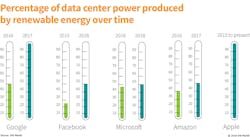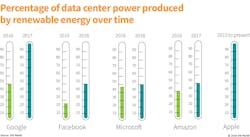Renewable energy in data centers on the rise: IHS Markit
IHS Markit's Maggie Shillington, cloud and data centers analyst, says that data centers are behind between 2% and 3% of developed countries' electricity consumption, with the electricity required for cooling being the most significant operational cost for most data centers. Many data center operators are turning to renewable energy sources to meet such needs, she says in a new report.
Shillington notes that although onsite generation in data centers, including wind and solar power, are among the most popular renewable energy methods, offsite renewable energy sources, such as renewable energy suppliers and utility companies, are the most straightforward way to attain renewable energy for data centers. Eliminating the large upfront capital expenses to produce onsite renewable energy, offsite generation removes the geographical limitations of renewable energy production approaches.
Small data centers as well as large can benefit from implementing onsite options. However, hyperscale data center owners such as Apple, Amazon, Facebook, Google, and Microsoft continue to propel renewable energy growth for data centers as a group. According to IHS Markit analysis, operators are motivated internally by possible energy cost savings or internal sustainability policies. They are driven externally by customer demands for companies to demonstrate environmentally friendly practices or governments subsidies or tax incentives, notes Shillington.
Shillington expects that with growing interest in renewable energy, onsite generation of that energy will become a data center design criterion, despite the likelihood of data centers continuing to use renewable energy credits (RECs) and other methods (where an onsite source of renewable energy is not necessary). Additionally, the importance of data center location will grow, as a facility's location near to, or far from an optimal climate for generating renewable energy can affect whether it has local renewable energy or not, Shillington says.
The designs and technology inside data centers enable facilities to efficiently store energy and minimize overall energy consumption. As these technologies improve further, data center operator interest will grow, making this a key factor for renewable energy use as well. Spending upfront to reduce energy usage by investments in renewable energy and these technologies will lessen the operational expense of powering data centers as well. IHS Markit anticipates that customers will choose to pay more for accessories and products that improve the efficiency of their data centers as a result.
This "Renewable Energy in Data Centers" report covers emerging methods and products evolving in tandem with the growth of the data center market's renewable energy adoption. The report also includes a survey of how hyperscale data center operators are implementing renewable energy, and current renewable energy application in data centers.
For related articles, visit the Business Topic Center.
For more information on high-speed transmission systems and suppliers, visit the Lightwave Buyer's Guide.

